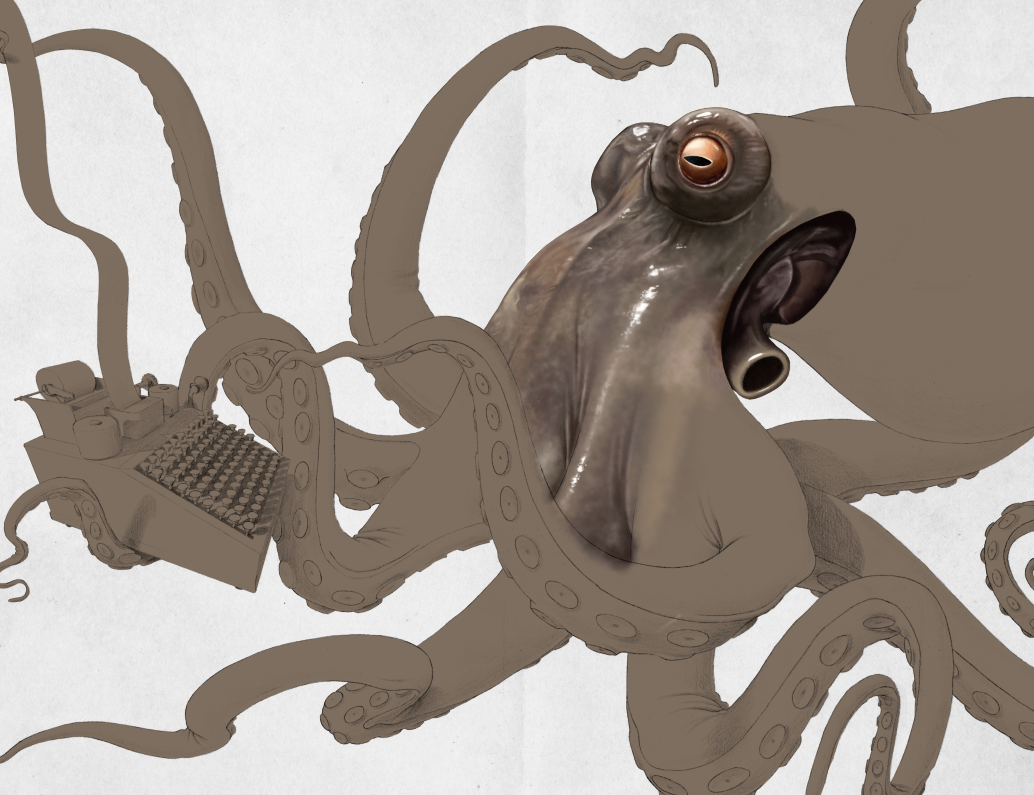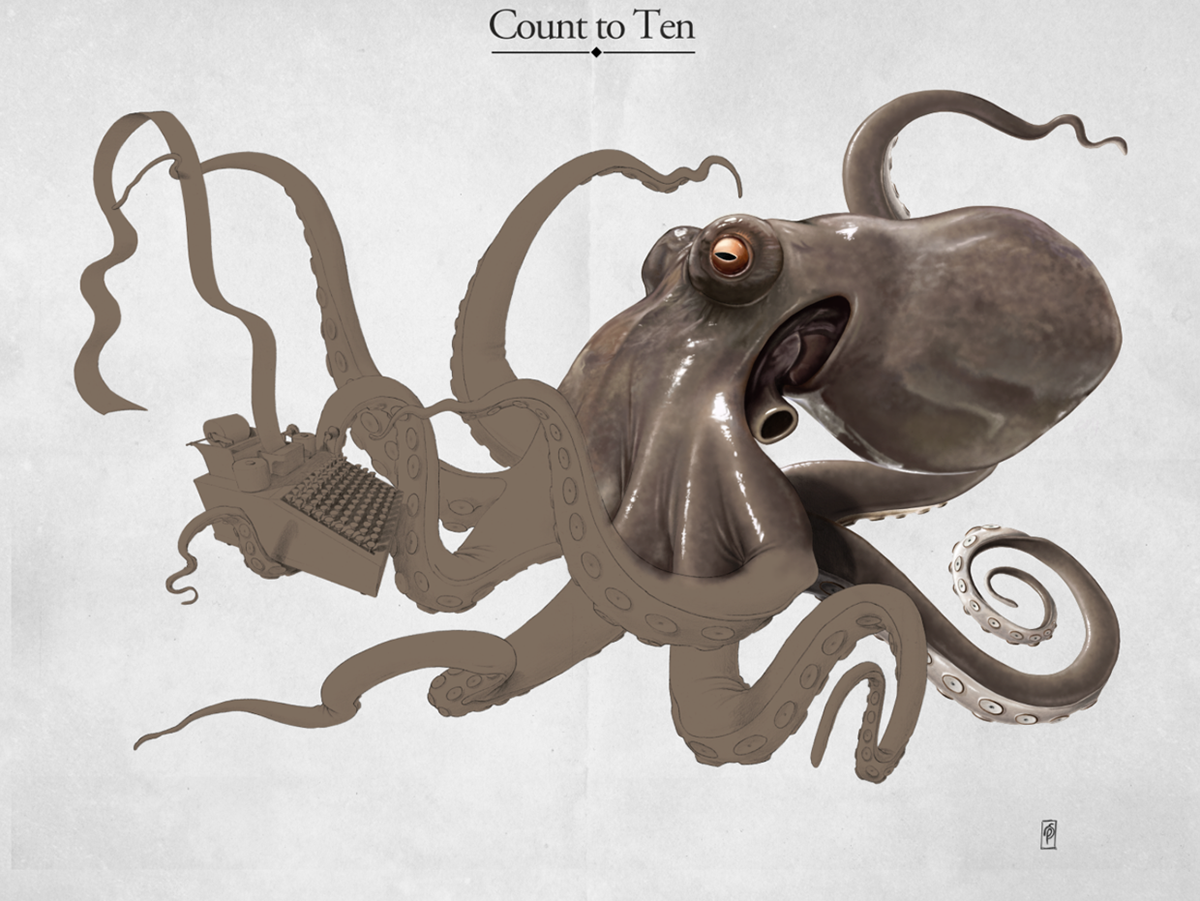

One of the things I remember about school (maybe not in a fond way) were my maths lessons. Once my creative path was decided, I looked back and really wondered hard to the point of algebra and trigonometry. My earliest recollection as a child was the elementary approach by which schools introduce the counting process. This was the beginning, and to start it was a case of counting to ten. Now, it's hard to understand why counting to ten was set as standard. However, the notion that we have ten fingers or ten toes seemed a rational way to decide on the approach. Kids would use their fingers (or toes) to add up.
Whilst searching for new ideas for the 'animal behaviour' series, and living in a country where swimming in the clear, blue-green mediterranean can sometimes gain a chance encounter with the elusive octopus, a thought popped into my head. If a creature like an octopus were in need of counting, would they employ the human standard. Also knowing that octopus is derived from the Greek word χταπόδι, which translates as eight feet, then it does seem a little unlikely this creature would find any use in that. So, to draw full circle on the humour aspect of these illustrations, the idea popped in of an octopus trying very hard to use an antique counting machine to get to 'count to ten'. But, no matter what he taps into the machine the arithmetic comes out as eight, as you would expect.
All images are now protected with Digimarc Guardian technology | copyright © Rob Snow 2011 - 2015
File size: 1.3Gbs/2.45Gbs (open)
Layers: 88 uncompressed
Dimensions: 12896x10000px
Hours (Pencil): 6hrs
Digital rendering: 40+ hrs



What I thought I would do, is go through my process a little more in this project presentation. It has gained a lot of interest in the WIP section, so thought it only right to maybe give an insight into how I work.
As with all good pieces of art and design, it begins with an idea. Without an idea, I feel artwork is merely a technique, and as the word aesthetics comes from the Greek aisthētikos, and translates as 'of the senses', I feel it important that the passion involved in the process of art is given the fruit of the imagination. Now, the usual starting point for my ideas comes from a strange connection I have built from doing lateral thinking (have to thank DeBono for that), I either have sparks of ideas from my dog walks, or doing the horizontal pseudo-nap technique and imagining great things, or it simply pops in there in a flash. However, many of my "animal behaviour" series are born from the connection from memories, or links to actualities I have heard in documentaries, or news items. Something that seems to have no relevance to that of nature. Also, I like the clever play I can get with English words. Because it is a contextual language, it is nice to play with this and to find words that are spelled the same, but can have interesting visual differences. This is what leads to the idea; linking the connections.

With 'Count to Ten' it was a simple sketch, like I tend to normally do (see above) that lays out the composition. Originally I was going to use an electronic calculator to define the number counting, but after some thought, and general dislike (aesthetically) of modern calculators I felt it was great to use an antique counting machine. I had memories of these with my grandparents and mother, who did some accounting. So, I searched for a good aesthetic looking counting machine, and was lucky to find the Burroughs.

I was even more lucky when I found that I could get this counting machine as a 3d model for SketchUp. Over the last two series of 'animal behaviour' I have employed the use of Google SketchUp, as a way to perfect the use of inanimate objects into more dynamic and clever compositions. So, if this is the case, as was with this, I spend time doing some set-up changes and test renders in outline of the 3d object to get the right angle. Then when I am happy, I have this printed out at 70x50cms on white paper, on which I do the necessary sketching of the creature for the piece. The animal tends to be built from several reference images I find on the internet. In the case of the octopus I was lucky, as the sketching was almost completed in the first draft. Some of the pieces take many passes to get the poses correct. The funny thing being, the more close to real human anatomy the more I am concerned with how it looks compositionally.

After the composition is laid out, I again have the final printed out (after adjusting for size on the paper in PS), at the 70x50cm aspect ration. I do this as a) there is Bristol Paper available, which I use, at that size, and b) the frames I use for my exhibitions from IKEA, come conveniently in that size.

Before I begin here, I want to set out a call of gratitude to @Ivan Pawluk, who after a discussion about brush qualities inside PS, shared his collection of brushes. You can find them here if interested. Ever since I started using them, I have found the quality of the work has increased. No more so than this image of the octopus. With many comments about the skin texture all I can state is it's all down to the brush!!
The creative process starts for the final composition once the scanned and scaled set-up piece has been printed. This is achieved with a piece of Bristol 220g paper being pinned to a board. The transfer is completed via a piece of transfer paper (you can see blue line in the image above), and then the graphite rendering commences. The reason I do this stage is to help enhance the edges and shaded areas of the piece. It creates a nice style, and even though a lot of the edge lines are removed, they work well as a guide for the painting.

Once in the computer, the scanned artwork is layered and set to 'multiply' mode in PS. This allows for painting under the drawing, as the white becomes transparent. You will see from the image above, that I also create a masking layer of the entire artwork area. This is done mainly to cut down of remaking masks.


Part of the knack in developing a good composition is allowing for section development. This is one of the main reasons I added the fore tentacle to cut across the main area of body. It made a convenient cut point for the painting. Which in fact took (on and off) 6 days to complete.
Also, I try to make the separate sections of the creature on different layers. And inside those layer groups, the highlights and shadows again can be separated from the mid-tone on new layers.
Also, I try to make the separate sections of the creature on different layers. And inside those layer groups, the highlights and shadows again can be separated from the mid-tone on new layers.

This images was achieved at the mid-point of the digital render. The tentacle painting actually became quicker.

Once the octopus was complete, the counting machine could be completed. Out of the six days, this took two to render out.









